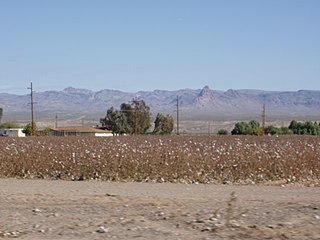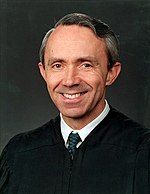
Tribal sovereignty in the United States is the concept of the inherent authority of indigenous tribes to govern themselves within the borders of the United States. Originally, the U.S. federal government recognized American Indian tribes as independent nations, and came to policy agreements with them via treaties. As the U.S. accelerated its westward expansion, internal political pressure grew for "Indian removal", but the pace of treaty-making grew nevertheless. The Civil War forged the U.S. into a more centralized and nationalistic country, fueling a "full bore assault on tribal culture and institutions", and pressure for Native Americans to assimilate. In the Indian Appropriations Act of 1871, Congress prohibited any future treaties. This move was steadfastly opposed by Native Americans. Currently, the U.S. recognizes tribal nations as "domestic dependent nations" and uses its own legal system to define the relationship between the federal, state, and tribal governments.
Oliphant v. Suquamish Indian Tribe, 435 U.S. 191 (1978), is a United States Supreme Court case deciding that Indian tribal courts have no criminal jurisdiction over non-Indians. The case was decided on March 6, 1978 with a 6–2 majority. The court opinion was written by William Rehnquist, and a dissenting opinion was written by Thurgood Marshall, who was joined by Chief Justice Warren Burger. Justice William J. Brennan did not participate in the decision.
Seminole Tribe of Florida v. Florida, 517 U.S. 44 (1996), was a United States Supreme Court case which held that Article One of the U.S. Constitution did not give the United States Congress the power to abrogate the sovereign immunity of the states that is further protected under the Eleventh Amendment. Such abrogation is permitted where it is necessary to enforce the rights of citizens guaranteed under the Fourteenth Amendment as per Fitzpatrick v. Bitzer. The case also held that the doctrine of Ex parte Young, which allows state officials to be sued in their official capacity for prospective injunctive relief, was inapplicable under these circumstances, because any remedy was limited to the one that Congress had provided.
Duro v. Reina, 495 U.S. 676 (1990), was a United States Supreme Court case in which the Court concluded that Indian tribes could not prosecute Indians who were members of other tribes for crimes committed by those nonmember Indians on their reservations. The decision was not well received by the tribes, because it defanged their criminal codes by depriving them of the power to enforce them against anyone except their own members. In response, Congress amended a section of the Indian Civil Rights Act, 25 U.S.C. § 1301, to include the power to "exercise criminal jurisdiction over all Indians" as one of the powers of self-government.
United States v. Kagama, 118 U.S. 375 (1886), was a United States Supreme Court case that upheld the constitutionality of the Major Crimes Act of 1885. This Congressional act gave the federal courts jurisdiction in certain Indian-on-Indian crimes, even if they were committed on an Indian reservation. Kagama, a Yurok Native American (Indian) accused of murder, was selected as a test case by the Department of Justice to test the constitutionality of the Act.

Indian country jurisdiction, or the extent which tribal powers apply to legal situations in the United States, has undergone many drastic shifts since the beginning of European settlement in America. Over time, federal statutes and Supreme Court rulings have designated more or less power to tribal governments, depending on federal policy toward Indians. Numerous Supreme Court decisions have created important precedents in Indian country jurisdiction, such as Worcester v. Georgia, Oliphant v. Suquamish Tribe, Montana v. United States, and McGirt v. Oklahoma.
Montana v. United States, 450 U.S. 544 (1981), was a Supreme Court case that addressed two issues: (1) Whether the title of the Big Horn Riverbed rested with the United States, in trust for the Crow Nation or passed to the State of Montana upon becoming a state and (2) Whether Crow Nation retained the power to regulate hunting and fishing on tribal lands owned in fee-simple by a non-tribal member. First, the Court held that Montana held title to the Big Horn Riverbed because the Equal Footing Doctrine required the United States to pass title to the newly incorporated State. Second, the Court held that Crow Nation lacked the power to regulate nonmember hunting and fishing on fee-simple land owned by nonmembers, but within the bounds of its reservation. More broadly, the Court held that Tribes could not exercise regulatory authority over nonmembers on fee-simple land within the reservation unless (1) the nonmember entered a "consensual relationship" with the Tribe or its members or (2) the nonmember's "conduct threatens or has some direct effect on the political integrity, the economic security, or the health or welfare of the tribe."
Santa Clara Pueblo v. Martinez, 436 U.S. 49 (1978), was a landmark case in the area of federal Indian law involving issues of great importance to the meaning of tribal sovereignty in the contemporary United States. The Supreme Court sustained a law passed by the governing body of the Santa Clara Pueblo that explicitly discriminated on the basis of sex. In so doing, the Court advanced a theory of tribal sovereignty that weighed the interests of tribes sufficient to justify a law that, had it been passed by a state legislature or Congress, would have almost certainly been struck down as a violation of equal protection.
Carcieri v. Salazar, 555 U.S. 379 (2009), was a case in which the Supreme Court of the United States held that the federal government could not take land into trust that was acquired by the Narragansett Tribe in the late 20th century, as it was not federally recognized until 1983. While well documented in historic records and surviving as a community, the tribe was largely dispossessed of its lands while under guardianship by the state of Rhode Island before suing in the 20th century.
United States v. White Mountain Apache Tribe, 537 U.S. 465 (2003), was a case in which the Supreme Court of the United States held in a 5–4 decision that when the federal government used land or property held in trust for an Indian tribe, it had the duty to maintain that land or property and was liable for any damages for a breach of that duty. In the 1870s, the White Mountain Apache Tribe was placed on a reservation in Arizona. The case involved Fort Apache, a collection of buildings on the reservation which were transferred to the tribe by the United States Congress in 1960.
South Dakota v. Bourland, 508 U.S. 679 (1993), was a case in which the Supreme Court of the United States held that Congress specifically abrogated treaty rights with the Cheyenne River Sioux Tribe as to hunting and fishing rights on reservation lands that were acquired for a reservoir.
Merrion v. Jicarilla Apache Tribe, 455 U.S. 130 (1982), was a case in which the Supreme Court of the United States holding that an Indian tribe has the authority to impose taxes on non-Indians that are conducting business on the reservation as an inherent power under their tribal sovereignty.
Ex parte Crow Dog, 109 U.S. 556 (1883), is a landmark decision of the Supreme Court of the United States that followed the death of one member of a Native American tribe at the hands of another on reservation land. Crow Dog was a member of the Brulé band of the Lakota Sioux. On August 5, 1881 he shot and killed Spotted Tail, a Lakota chief; there are different accounts of the background to the killing. The tribal council dealt with the incident according to Sioux tradition, and Crow Dog paid restitution to the dead man's family. However, the U.S. authorities then prosecuted Crow Dog for murder in a federal court. He was found guilty and sentenced to hang.
Oneida Indian Nation of New York v. County of Oneida, 414 U.S. 661 (1974), is a landmark decision by the United States Supreme Court concerning aboriginal title in the United States. The original suit in this matter was the first modern-day Native American land claim litigated in the federal court system rather than before the Indian Claims Commission. It was also the first to go to final judgement.
The following outline is provided as an overview of and topical guide to United States federal Indian law and policy:
Iron Crow v. Oglala Sioux Tribe of Pine Ridge Reservation, 231 F.2d 89, was a case where the plaintiffs challenged the authority of Indian tribal courts. The case, involving both adultery and tax assessment, was heard by the United States Court of Appeals for the Eighth Circuit.
Oklahoma Tax Commission v. Sac & Fox Nation, 508 U.S. 114 (1993), was a case in which the Supreme Court of the United States held that absent explicit congressional direction to the contrary, it must be presumed that a State does not have jurisdiction to tax tribal members who live and work in Indian country, whether the particular territory consists of a formal or informal reservation, allotted lands, or dependent Indian communities.
United States v. John, 437 U.S. 634 (1978), was a case in which the Supreme Court of the United States held that lands designated as a reservation in Mississippi are "Indian country" as defined by statute, although the reservation was established nearly a century after Indian removal and related treaties. The court ruled that, under the Major Crimes Act, the State has no jurisdiction to try a Native American for crimes covered by that act that occurred on reservation land.
Antoine v. Washington, 420 U.S. 194 (1975), was a United States Supreme Court case in which the Court held that treaties and laws must be construed in favor of Native Americans (Indians); that the Supremacy Clause precludes the application of state game laws to the tribe; that Congress showed no intent to subject the tribe to state jurisdiction for hunting; and while the state can regulate non-Indians in the ceded area, Indians must be exempted from such regulations.
Michigan v. Bay Mills Indian Community, 572 U.S. 782 (2014), was a United States Supreme Court case examining whether a federal court has jurisdiction over activity that violates the Indian Gaming Regulatory Act but takes place off Indian lands, and, if so, whether tribal sovereign immunity prevents a state from suing in federal court. In a 5–4 decision, the Court held that the State of Michigan's suit against Bay Mills is barred by tribal immunity.







